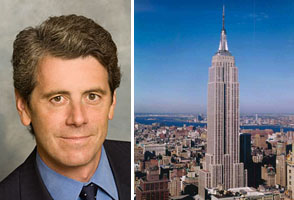Trending
Empire State Building earnings double in 2009, but remain below 2007 levels

Anthony Malkin and the Empire State Building
The Empire State Building’s financial situation improved in 2009 with a doubling of net operating income from the prior year. Despite that, it was unable to accomplish its major financial goal of obtaining large loans to fund an anticipated 10-year, $626 million rehabilitation of the building.
The net operating profit for the 2.8 million-square-foot office tower at 350 Fifth Avenue was $16 million in 2009, up from $8 million in 2008, property owner Empire State Building Associates said in documents filed with the U.S. Securities and Exchange Commission Tuesday. However, it was still far below the $35 million profit earned in 2007, federal filings showed.
Both Empire State Building Associates and the building’s operating entity, Empire State Building Company, are controlled by Malkin Holdings, which declined to comment.
The filing indicates the building remains healthy despite a decline in asking rents and last year’s replacement of CB Richard Ellis with Newmark Knight Frank as the office leasing brokerage firm. This year, the building has been in the spotlight with an unsuccessful public effort by Anthony Malkin, president of Malkin Holdings, to block the development of 15 Penn Plaza, a competing office tower Vornado Realty Trust plans to build two avenues to the west. CBRE remains the leasing broker for the retail space in the Empire State Building, located between 33rd and 34th streets.
The average annual rent tenants are paying was $29 per square foot in 2009, a decline of $1 per foot compared with 2008 when they were $30 per square foot. Asking rents fell further, to a range of $32 per foot to $52 per foot, as of the end of 2009 compared with $50 per foot to $60 per foot at the end of 2008, the company’s SEC filings show.
But the company that manages the building and controls it through a master lease on the building, Empire State Building Company, was not able to obtain financing above $71.5 million for the $626 million rehabilitation, the report says.
The Empire State Building Company “has not achieved its own required internal approvals for such financing beyond approximately $71.5 million,” the report says. Instead the improvements will be paid through cash flow, cutting annual payments to the owners of the 3,300 outstanding shares, known as participations, from more than $5,000 per year to just over $1,000 per year.
Funding building improvements through available cash flow indicates a conservative approach to ownership, but makes sense in the current environment with financing difficult to obtain, real estate attorney Eric Zipkowitz, a partner at Tarter Krinsky & Drogin, said. He is not involved with the building or its finances.
“While the participants might not be happy about reduced cash flow on a short-term basis, my guess is that as the market continues to improve and stabilize, the current strategy should pay off for all when additional outside financing is eventually obtained,” Zipkowitz said in an e-mail.




